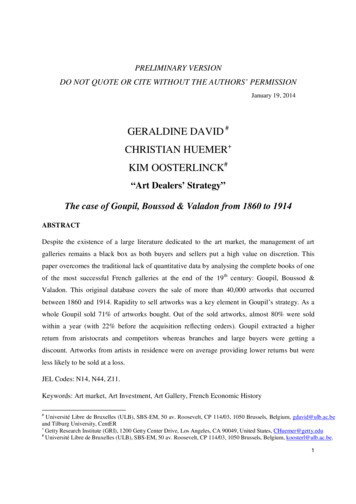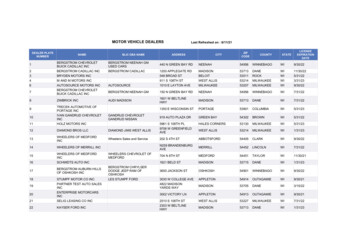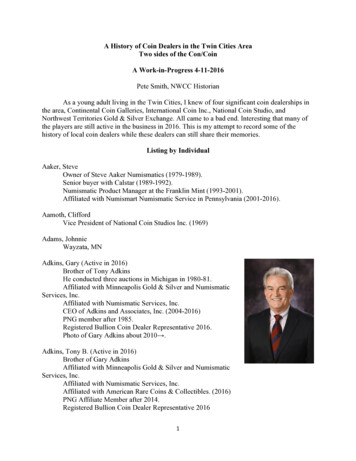
Transcription
PRELIMINARY VERSIONDO NOT QUOTE OR CITE WITHOUT THE AUTHORS’ PERMISSIONJanuary 19, 2014GERALDINE DAVID #CHRISTIAN HUEMER KIM OOSTERLINCK#“Art Dealers’ Strategy”The case of Goupil, Boussod & Valadon from 1860 to 1914ABSTRACTDespite the existence of a large literature dedicated to the art market, the management of artgalleries remains a black box as both buyers and sellers put a high value on discretion. Thispaper overcomes the traditional lack of quantitative data by analysing the complete books of oneof the most successful French galleries at the end of the 19th century: Goupil, Boussod &Valadon. This original database covers the sale of more than 40,000 artworks that occurredbetween 1860 and 1914. Rapidity to sell artworks was a key element in Goupil’s strategy. As awhole Goupil sold 71% of artworks bought. Out of the sold artworks, almost 80% were soldwithin a year (with 22% before the acquisition reflecting orders). Goupil extracted a higherreturn from aristocrats and competitors whereas branches and large buyers were getting adiscount. Artworks from artists in residence were on average providing lower returns but wereless likely to be sold at a loss.JEL Codes: N14, N44, Z11.Keywords: Art market, Art Investment, Art Gallery, French Economic History#Université Libre de Bruxelles (ULB), SBS-EM, 50 av. Roosevelt, CP 114/03, 1050 Brussels, Belgium, gdavid@ulb.ac.beand Tilburg University, CentER Getty Research Institute (GRI), 1200 Getty Center Drive, Los Angeles, CA 90049, United States, CHuemer@getty.edu#Université Libre de Bruxelles (ULB), SBS-EM, 50 av. Roosevelt, CP 114/03, 1050 Brussels, Belgium, koosterl@ulb.ac.be.1
IntroductionA large academic literature has been dedicated to the prices of artworks, with a focus onart as an investment vehicle1. Because of data constraints the literature has been relying onauction house data to construct price indices and this, even though galleries represent a verysubstantial part of the art market. Indeed, Velthuis (2005, p. 14) assesses the size of the USauction market at 1,298 million USD to be compared with the art dealers’ market estimated at2,834 million USD. Dealers’ markets are also larger than auction markets in France (Gaillard,1999) or in The Netherlands (Velthuis, 2005). As for record breaking sales many were doneoutside auction houses such as for example the 137.5 million USD sale of Woman III fromWillem de Koning orchestrated by Larry Gagossian (Vogel, 2006). The absence of gallery pricesis easy to understand: as going-concerns buyers and sellers put a high price on discretion. Whengalleries are mentioned in the economics literature it is mostly to stress the role of some galleryowner in shaping artists’ careers. For example, the role of Durand-Ruel or Kanhweiler indeveloping markets for their protégés has been discussed in detail by art historians andeconomists working on artists’ wages. Research conducted on these gallery owners tend howeverto neglect prices providing only isolated figures. Velthuis (2005) is an exception in the field. Onbasis of interviews conducted both in the Netherlands and in the US he shows that prices in theart world have a symbolic meaning. His fascinating work is however focused on a short timespan and is only covering sale prices without reference to the acquisition prices.Focusing solely on auction data is thus likely to provide an incomplete picture of the artmarket. Buyers at auction may have a varied set of objectives ranging from investment toconsumption. In some instances and as shown by Mandel (2009) and Oosterlinck (2013)conspicuous consumption may become an important driver of art prices. In the case of galleries,and even though many gallery owners are at heart art lovers enjoying the consumption ofartworks, revenues from art sales have to be high enough to allow the gallery to survive. On topof that gallerists often have a privileged relationship or an exclusivity contract with artists, but1See for example Baumol, 1986, Frey and Pommerehne, 1989, Pesando, 1993, Ginsburgh and Buelens (1992),Goetzmann (1993), Mei and Mooses (2002) and Renneboog and Spaenjers (2013)2
the returns they manage to extract thanks to these elements remain to this day elusive. Pricing ofartworks in the framework of a gallery is a real business strategy. Analysing this strategy is thuskey to get a better understanding of artwork prices.This paper exploits a unique historical case to analyse the pricing strategy of a major artgallery. Whereas galleries still active today cannot be quantitatively analysed because ofdisclosure limitations, history provides a way to analyse them. This is the approach chosen forthis paper which focuses on one of the most successful French gallery active during the end ofthe 19 th and beginning of the 20th century: the maison Goupil and its successor Boussod andValadon. Goupil’s archives are unique in many respects. First, its books are complete, somethingexceptional for the period under consideration as many art dealers at the time had onlyrudimentary accounts. Even famous dealers such as Durand-Ruel followed no coherentaccounting practices which, by Durand-Ruel’s own account, proved detrimental to his business(Fénéon, 1920). Second, the books cover a large period (1846-1919) and allow analysing theimpact of the change in ownership on the gallery’s strategy. Eventually the number of entries islarge covering more than 40,000 unique artworks.On basis of this unique database, the paper analyses the pricing strategy of Goupil. DidGoupil extract higher returns from some social groups (nobles, women, other gallery owners)?Were large buyers rewarded? To which extent did Goupil manage to sell its artworks in a rapidway? Auction data shows that an artwork failing to sell at auction will be sold at a much lowerprice (Ashenfelter and Graddy, 2003). Is a similar pattern observable for artworks sold bygalleries? And if so, when did Goupil consider the artwork as “burned” and decided to let it gofor a low price? What was the average return on artworks sold? Did the size of the stock of agiven artist influence the pricing? In which cases was Goupil ready to sell artworks at a loss?The balance of the paper is organized as follows: Part 1 provides a short overview of thehistory of the maison Goupil and the context in which it operated. Part 2 presents the dataset andthe methodology. Part 3 provides the results of the investigation, whereas Part 4 concludes.3
I.The Maison Goupil and the Paris Art Market during the 19th centuryThe origins of the Maison Goupil may be traced back to the partnership formed inFebruary 1829 between Adolphe Goupil and Henry Rittner. At first the partnership specialized inprints, reproducing famous artworks for a broad public. The market for such prints was large andmany businesses were active in this field. Rittner & Goupil managed however to run business ina different way. As pointed out by McIntosh (2004, p. 64), “it was the only one to develop avertically integrated system of reproduction and dissemination that operated seamlessly, wall towall, from the artist’s studio to the collector’s parlor and often from there to the museum’sgalleries”. As a result, Rittner & Goupil became one of the major players worldwide in the printbusiness. The death of Rittner, in 1840, prompted Adolphe Goupil to create a new company withanother printer, Théodore Vibert (Penot, 2013, p. 49). This company first named Goupil &Vibert and from 1846 on Goupil, Vibert & Cie, specialized in the sale of prints. Soon, thesuccess was such that the workshops of the company had to be relocated to get additional space.At the same time, the company developed a broad international network to expand its business(Penot, 2010). A large proportion of the company’s activities were thus conducted abroad.Expansion took either the form of a joint-venture or in some instances led to the creation of abranch of the mother company (Penot, 2010). The company opened a branch in New York in1848 and began a close relationship with the Van Gogh2 gallery in The Hague in 1846.The death of Vibert, in 1850, led once more to a change in name, the new business becomingGoupil & Cie. A new associate, Léon Boussod joined a few years after. The core of the businessremained the sale of prints up till 1860 as shown by the inventory of paintings held by Goupil(Penot, 2013). From 1850 to 1860 however, the business gradually changed and by 1860, sellingpaintings had become the main business of the company. In 1853 Goupil began to have artists inresidence. After 1865 the number of artists in residence increased substantially (Penot, 2013).For the 19th century more than 117 artists spent at least some time in Goupil’s main building2Run by Vincent Van Gogh, the uncle (“Uncle Cent”) of his homonym, the painter.4
located rue Chaptal. Such course of action was not exceptional for the 19 th century. For example,in 1878 Charles Sedelmeyer entered in an exclusive contract with the painter Mihály Munkácsy(Huemer, 2004). Goupil specialized in well established artists. For example, when WilliamAdolphe Bouguereau signed a twenty years exclusivity contract with Goupil, in 1865, he hadalready won the prestigious prizes in France such as the Prix de Rome or a medal at the Salon(Galenson and Jensen, 2002).During these years the company pursued its international strategy by opening a branch inLondon in 1857 following one in Berlin in 1852. As for the New York branch its success wassuch that its manager, Schaus, resigned to open his own gallery. The successor, MichaelKnoedler, substantially developed the business and eventually bought it back from Goupil in1857 (Penot, 2013). By 1861, Goupil had managed to open three galleries in Paris and fourabroad. This year marked the beginning of an official association with Vincent Van Gogh. Fromthen on the business of paintings would become the most important one. The years 1870-1884marked, according to Penot (2013), the consecration of the company. In 1878, Vincent VanGogh retired to be replaced by René Valadon, Boussod’s son in law. In 1884, the companychanged name again to become Boussod, Valadon & Cie, successeur de Goupil et Cie.The art environment in which Goupil operated experienced major changes during the periodunder study. The French artistic scene was up till the second half of the 19 th centurycharacterized by a highly hierarchical system. As in other domains, France had created a verycentralized system centred on two institutions the Académie des Beaux-Arts and the Salon (agreat annual or biennal exhibition). Would be artists were expected to train at the Académie andif they were good enough to present their work in the framework of the Salon, the main if notonly real exhibition place for visual arts (Jensen, 1994). Additional recognition of artists’ worthcould gradually be gained by winning prestigious prizes (such as the Prix de Rome) or medals atthe Salon. As time went by the system suffered from growing criticisms. Members of the jurywere accused of being partial and the increasing number of refused paintings fuelled resentmentamongst painters. Indeed, public commissions were often conditioned on having been recognizedby the Salon. Furthermore many art buyers were relying on the Salon to guide their choice.5
White and White (1965) have argued that the Salon system focused essentially on paintingsrelegating artists’ careers to a second zone. The increase in the number of professional paintersrendered the system unsustainable. The impressionists led to the creation of a new system, whichWhite and White (1965) have labelled as the “dealer-and-critic system”. They contend that alarge number of dealers began to focus on the artists’ careers and list more than a hundred of artdealers. Since dealers were interested in the future success of their protégés, they invested inmarket development and reputation building. Jensen (1994) and Galenson and Jensen (2002)have criticized the presentation made by White and White (1965); Galenson and Jensen (2002)point out the fact that impressionists developed their own exhibition to gain reputation and thatart dealers investing in young artists’ were the exception, certainly not the norm. Only a handfulof art dealers were promoting young artists and the market for ancient and modern paintings wasclearly segmented. Gallerists promoting living artists were not necessarily investing in the avantgarde movements. Goupil was mostly following well-established artists. Durand Ruel and Petitwere taking the risks to support the impressionists but most galleries were at first not interestedin these artists. As stressed by Galenson and Jensen (2002, 22) “For the already well-establishedartist, the large dealer’s gallery was the most convenient means to translate one’s reputation intosales. But young, unknown artists were never beneficiaries of large-scale dealer purchases”.Even though the importance of the Salon diminished during the 19th century it still remainedof paramount importance up till the First World War. Indeed most art periodicals were giving amuch stronger focus on the Salon than on any other alternative exhibition (Jensen, 1994). Amajor change in the 19th century art market was the growing importance of a truly internationalart market. Painters had to take into account the potential provided by foreign sales. Jensen(1994) also stresses the growing importance of dealers during the second half of the 19th century.Even well-established painters relied on the efforts of their dealers to gain access to new marketsor develop existing ones.6
II.Data and Descriptive statisticsThe data series used in this paper have been collected from the fifteen Goupil bookspreserved at the Getty Research Institute. The books report all artwork transactions (close to44,000 transactions) for a period ranging from 1848 to 1919. For each artwork, the name of theartist, the title of the work as well as the date and price of
Even famous dealers such as Durand-Ruel followed no coherent accounting practices which, by Durand-Ruel’s own account, proved detrimental to his business (Fénéon, 1920). Second, the books cover a large period (1846-1919) and allow analysing the impact of the change in ownership on the gallery’s strategy. Eventually the number of entries is large covering more than 40,000 unique artworks .











